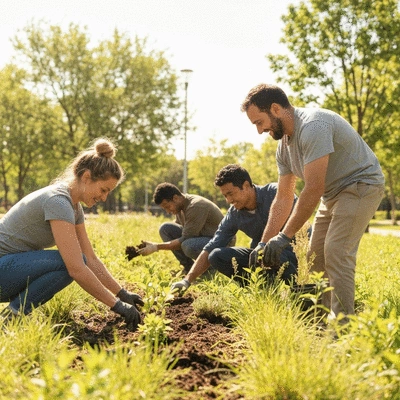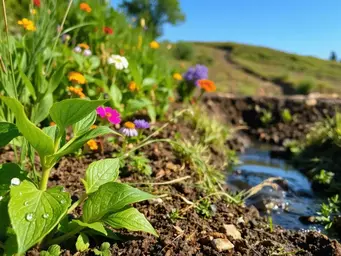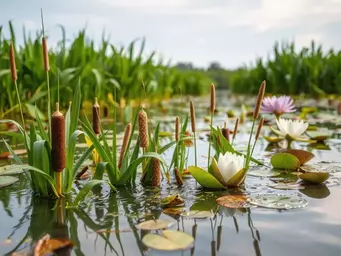Native Plants: Ecological Advantages
Water Quality Enhancement
- ✓ Filters Pollutants (Roots)
- ✓ Reduces Algal Blooms
- ✓ Nutrient Cycling
Soil Stability & Health
- ✓ Deep Root Systems Anchor Soil
- ✓ Prevents Erosion & Runoff
- ✓ Increases Organic Matter
Did you know that native plants play a crucial role in enhancing water quality and stabilizing soil? Their benefits extend far beyond aesthetics, making them vital for healthy ecosystems. Dive into the key takeaways to understand their significance in environmental restoration.
Native plants significantly enhance water quality and stabilize soil compared to non-native species. The visual below highlights key aspects of their ecological advantages.
As an environmental scientist, I’ve seen firsthand the incredible benefits that native plants bring to our ecosystems. They play a critical role in enhancing water quality and stabilizing soil, which is essential for the health of our wetlands and surrounding environments. Understanding the connection between these plants and environmental health is vital for anyone involved in restoration projects.
Native plants are adapted to local conditions, meaning they can thrive without excessive irrigation or fertilizers. This natural resilience helps improve water quality by filtering pollutants and providing habitat for wildlife. Let's dive into how these plants influence both water quality and soil stability!
The relationship between native plants and environmental health is profound. These plants are not just beautiful additions to our landscapes; they are integral to maintaining ecological balance. For instance, native plants contribute to improving water quality in several ways:
With such benefits, it’s clear that integrating native plants into restoration projects can foster healthier ecosystems. Now, let’s explore how these plants specifically enhance water quality.
Native plants have evolved alongside their local environments, developing mechanisms that help purify water. Through their roots, these plants can filter out sediments and contaminants, effectively acting as natural water treatment systems. Imagine a wetland where the roots of native reeds and sedges draw in nutrients, thereby reducing the chances of algal blooms in nearby waterways.
This filtration process is crucial, as it not only cleans the water but also supports aquatic life. By maintaining clean water, native plants ensure that local wildlife thrives, reinforcing the ecological web. It’s a beautiful cycle that underscores the importance of choosing native species in our restoration efforts, as highlighted by organizations like the Homer Soil and Water Conservation District.
Soil stability is another essential function that native plants provide. Their deep and complex root systems anchor the soil, preventing erosion and promoting healthy soil structures. A well-established root network can significantly reduce runoff, which is especially important in areas prone to flooding.
Moreover, native plants enhance soil health by contributing organic matter as they die back and decompose. This organic matter acts as a sponge for moisture, ensuring that the soil retains water better, which is vital for plant resilience during dry spells.
Diving deeper into the ecological mechanisms, let’s consider the specific ways that native plants improve water quality through their unique characteristics.
Each of these elements plays a crucial role in fostering a vibrant and sustainable ecosystem. By selecting native plants that are suited to local conditions, we can maximize their positive impacts on both water quality and soil stability.
The roots of native plants are incredibly efficient at filtering out pollutants. Their fibrous structures trap sediments and absorb harmful nutrients, like nitrogen and phosphorus, that can negatively affect water bodies. This natural filtration system is essential for maintaining the health of aquatic ecosystems and preventing contamination.
When planting native species, we not only beautify our landscapes but also enhance the resilience of water systems. Witnessing this transformation is what drives my passion for wetland restoration!
Nutrient cycling is a vital process facilitated by native plants, as they help balance nutrient levels in the soil and water. When these plants decompose, they release nutrients back into the environment, which can then be utilized by other plants and organisms, creating a thriving ecosystem.
This cycle is crucial for watershed management. By ensuring nutrients are cycled effectively, we minimize the risk of nutrient overload in water bodies, which can lead to detrimental consequences like algal blooms.
Riparian buffers, comprised of native vegetation, serve as protective zones between water bodies and developed land. They filter pollutants from runoff, provide habitat for wildlife, and reduce erosion along waterways. Think of a lush buffer filled with native shrubs and trees — it’s not just beautiful; it’s a critical defense against water quality degradation!
By restoring these buffers along rivers and streams, we can significantly improve the health of our water systems and enhance the biodiversity that depends on them.
Next, let’s explore how native plants contribute to soil health and structural improvement. Healthy soil is the foundation of a resilient ecosystem, and native vegetation plays a pivotal role in enhancing this aspect.
Understanding these components helps us realize why native plants are essential for land restoration projects.
As previously mentioned, the root systems of native plants are crucial for soil stability. Their deep roots not only anchor the soil but also create spaces for air and water to penetrate. This aeration is vital for soil health and the organisms that inhabit it, ensuring that the soil remains productive.
When we plant native species, we’re not just enhancing the landscape; we’re building a stronger foundation for future growth. It’s a win-win situation!
Mycorrhizal fungi form symbiotic relationships with the roots of native plants, enhancing nutrient uptake and improving soil structure. These fungi extend root systems and help plants access water and nutrients that would otherwise be out of reach.
This collaboration is a beautiful example of how interconnected our ecosystems are. By incorporating native plants into restoration efforts, we encourage the presence of these beneficial fungi, which in turn supports overall soil health and productivity, as detailed in research on HortScience journals.
Soil organic matter is essential for maintaining soil functionality and stability. Native plants contribute significantly to this organic matter through leaf litter and root decay. This organic material helps retain moisture, increases soil fertility, and improves overall soil structure.
By fostering a rich layer of organic matter, we ensure that the soil can support various plant and animal life, reinforcing the entire ecosystem. It’s incredible to witness how native vegetation can revitalize degraded landscapes and create thriving habitats.
When it comes to restoration projects, a comparative analysis between native and non-native plants reveals significant differences in their effectiveness. Understanding these differences can help guide our planting choices.
Let’s delve deeper into how these factors play a role in successful restoration initiatives.
Native plants outperform non-native species when it comes to erosion control and water retention. Their root systems are designed to withstand local conditions, allowing them to thrive in various environments and provide effective soil stabilization. The Tualatin Soil and Water Conservation District's research on climate-adapted plants further illustrates this resilience.
In contrast, non-native plants may not have the same adaptability, leading to increased erosion and reduced water retention. Choosing native species can significantly enhance the success of restoration projects, ensuring long-lasting ecological benefits.
One of the most significant long-term benefits of using native species is their resilience and ability to adapt to changing environmental conditions. Native plants require fewer resources to thrive, making them more sustainable choices for restoration projects.
Additionally, they support local wildlife and maintain the ecosystem's balance, which is crucial for biodiversity. By prioritizing native species, we can ensure the longevity of our restoration efforts!
Invasive species can disrupt the balance of local ecosystems, often outcompeting native plants for resources. This can lead to decreased biodiversity and compromised ecosystem health. By focusing on native plants, we can help combat the spread of invasives and protect our precious ecosystems from further degradation.
As we work toward restoring wetlands and other habitats, understanding the influence of invasive species should guide our decisions. It’s essential to create environments where native plants can thrive and ecosystems can flourish.
Now that we understand the importance of native plants, let’s discuss practical implementation strategies for using them effectively in restoration projects.
These strategies can help maximize the benefits of native plants and contribute to successful restoration efforts.
Developing a comprehensive restoration plan is essential for any project involving native plants. This plan should consider local soil and water conditions, existing vegetation, and the specific goals of the restoration initiative.
By tailoring the restoration approach to the unique characteristics of the area, we can enhance the effectiveness of our efforts and ensure long-term success.
Choosing the right species for your specific soil and water conditions is vital. Conducting a thorough assessment of the site can help identify which native plants will thrive and contribute the most to the ecosystem. For example, wetland areas may benefit from species like bulrush or cattails, while drier areas could support native grasses and wildflowers.
By selecting species that are well-suited to local conditions, we increase the chances of successful establishment and long-term ecological benefits.
Incorporating native plants into green infrastructure projects can effectively manage stormwater and enhance water quality. Bioretention cells, green roofs, and vegetated swales using native vegetation can absorb runoff, filter pollutants, and recharge groundwater.
Implementing such strategies not only improves water quality but also creates beautiful, functional landscapes that support local wildlife. It’s a practical way to merge aesthetics with ecological benefits!
Examining case studies of successful native plant integration can provide valuable insights for our restoration efforts. Let’s look at some regional success stories and the lessons we can learn from them.
By understanding these experiences, we can better navigate our restoration projects and enhance their effectiveness.
Throughout my career, I've come across several inspiring success stories of native plant integration that highlight their profound impact on local ecosystems. For example, in the Pacific Northwest, numerous community-led initiatives have restored degraded wetlands using native species.
These projects not only revitalized the habitats but also engaged local communities in stewardship and education. The lessons learned from these successes can guide us in implementing similar projects in our own regions.
Of course, not every project goes as planned. There have been challenges and failures in native plant projects that teach us important lessons. From the introduction of invasive species to inadequate site assessments, these issues can hinder restoration efforts.
By analyzing these failures, we can develop strategies to avoid similar pitfalls in our own projects. It’s all about learning and adapting to ensure our restoration efforts are as effective as possible!
Finally, assessing the long-term effects of habitat restoration efforts involving native plants is crucial. Monitoring changes in biodiversity, soil health, and water quality can provide insights into the success of our restoration initiatives.
By committing to ongoing evaluation, we can ensure that our efforts lead to lasting positive impacts on our ecosystems. It’s a reminder that restoration is not just a one-time event; it’s a continuous journey toward sustainability!
As we look to the future, there is significant potential for expanding the use of native plants in urban environments. Incorporating these plants into our cities can enhance biodiversity and improve overall ecological health.
By embracing these strategies, we can create vibrant, resilient urban ecosystems that benefit both people and wildlife.
In urban settings, incorporating native vegetation into stormwater management practices can significantly reduce runoff and improve water quality. Using plants adapted to local conditions allows for more effective absorption and filtration of pollutants.
Implementing bioretention areas with native plants in parking lots or public parks can enhance stormwater management while providing beautiful green spaces for communities to enjoy!
Native plants offer numerous benefits in urban green spaces, including improved aesthetics, enhanced biodiversity, and increased resilience to climate change. These green spaces become vital habitats for pollinators and other wildlife, contributing to urban ecology.
As we integrate native vegetation into city landscapes, we create healthier environments for people and nature alike.
To enhance biodiversity in urban landscapes, we must prioritize the planting of native species in parks, gardens, and public spaces. Creating corridors of native vegetation can significantly benefit wildlife and promote ecological connectivity.
By encouraging community involvement in these initiatives, we can cultivate a shared sense of stewardship and inspire collective action toward preserving our natural heritage.
When planning your native plant restoration project, consider creating a diverse planting scheme that includes a mix of grasses, wildflowers, and shrubs. This diversity not only enhances the aesthetic appeal but also boosts ecosystem resilience, ensuring that the area can better withstand pests, diseases, and changing environmental conditions.
Native plants primarily improve water quality by filtering pollutants and excess nutrients from runoff through their root systems. This natural filtration helps prevent contamination and reduces the likelihood of issues like algal blooms in water bodies.
Native plants have deep and complex root systems that effectively anchor the soil. This prevents erosion, reduces runoff, and promotes healthy soil structures by creating spaces for air and water penetration, and by adding organic matter as they decompose.
Native plants are adapted to local conditions, meaning they have evolved to thrive in the specific climate, rainfall patterns, and soil types of their region. This inherent adaptability makes them more resilient to extreme weather and changing environmental conditions compared to non-native species.
Riparian buffers are protective zones of native vegetation located between water bodies (like rivers and streams) and developed land. They are crucial because they filter pollutants from runoff, reduce erosion along waterways, and provide vital habitat for wildlife, thereby enhancing overall water quality and ecosystem health.
Communities can get involved through educational outreach, workshops, and organized planting events. Encouraging local schools, clubs, and organizations to participate fosters a shared sense of stewardship and promotes collective action towards preserving natural heritage and restoring ecosystems.
As we dive deeper into the world of native plants, it's clear that their role in enhancing water quality and stabilizing soil is multifaceted. These plants not only improve the ecological health of our environments but also offer significant benefits to the communities that embrace them. By restoring native plant communities, we can foster a more sustainable future while enhancing the resilience of our wetland ecosystems!
Here are some of the most compelling benefits associated with native plant restoration:
Integrating native plants into our restoration projects is not just a trend; it's a necessity for fostering environmental sustainability. These communities create a dynamic relationship with local ecosystems, supporting wildlife and enhancing the overall health of our landscapes.
For instance, native plants promote biodiversity and contribute to the resilience of our ecosystems. This is especially important as we face the challenges posed by climate change and habitat loss. When we enrich our landscapes with native flora, we create a living tapestry that thrives on the natural rhythms of the environment.
One of the most significant advantages of embracing native plants is their contribution to environmental sustainability. Native species are perfectly suited to their local environments, requiring less water and fewer resources than non-native alternatives. This leads to lower maintenance costs and a reduced ecological footprint, which is a win-win for both nature and our communities.
Moreover, native plants have adapted to support local wildlife, fostering a balanced ecosystem. By choosing native plants for restoration projects, we not only enhance the beauty of our landscapes but also reinforce the intricate connections among various species and their habitats.
Are you ready to take the plunge into native plant restoration? It might seem daunting, but with the right resources and support, you can make a significant impact in your community. Here are some actionable steps to get started:
To assist you on your journey, there are numerous resources available. Whether you’re looking for guidelines on plant selection or tools for community engagement, the following can be invaluable:
Getting your community involved is key to the success of native plant projects! One of the most effective ways is through education and outreach. Host workshops, provide informational resources, or organize community events to raise awareness about the benefits of native plants.
Encourage local schools, clubs, and organizations to participate. By fostering a collective spirit of stewardship, we can create a powerful movement for the restoration and preservation of our wetland ecosystems, ensuring they thrive for generations to come.
Here is a quick recap of the important points discussed in the article:



 In navigating the world of wetland restoration, understanding the financial landscape is paramount.
In navigating the world of wetland restoration, understanding the financial landscape is paramount.
 Did you know that native plants play a crucial role in enhancing water quality and stabilizing soil?
Did you know that native plants play a crucial role in enhancing water quality and stabilizing soil?
 Have you ever considered the profound impact that native plants can have on wetland ecosystems? Thes
Have you ever considered the profound impact that native plants can have on wetland ecosystems? Thes
 What would happen if our wetlands disappeared? The loss of these critical ecosystems could lead to d
What would happen if our wetlands disappeared? The loss of these critical ecosystems could lead to d